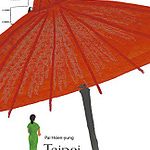In the 2020 surge in the Black Lives Matter movement stemming from the Murder of George Floyd, an increasing amount of Asian Americans have felt motivated to add their voice to the protest. (This is a good thing!)
Earlier in 2020, COVID-19-invoked racism gave us a sharp reminder that we are still viewed as the perpetual other. From the lazy microaggressions pairing COVID-19 articles with unrelated pictures of (Masked!) Asians, to the pre-meditated acts of violence urged on by the President's racist rhetoric, Asian Americans felt they were once again straddling the precipice of societal rejection.
2020 is also a reminder that many Americans can not or do not care to differentiate between Asian ethnicities. Historically, we have tried to create that distinction for the rest of America, voluntarily setting ourselves apart from the "enemy" (which usually meant whichever ethnicity that America was fighting across the Pacific) and self-identifying as the "good Asians" to prevent our families from being placed in internment camps, or investigated for Communist ties. Thus when Asian Americans, freshly reminded of their new tenuous foothold in society, witnessed Hmong American police officer Tou Thao complicit in the murder of George Floyd, many were quick to distance themselves and condemn him.
Condemnation is easy— it does double work in this unfortunate situation by making us feel that we've done our duty as allies to the Black community while joining White Liberal America in Woke Theater. What is not easy is confronting the complicated makeup of the Asian American community and acknowledging the differences in social and economic opportunities that are afforded various Asian subgroups in America.
The first inkling of our collective identity emerged around 1968 when Berkeley students Emma Gee and Yuji Ichioka coined the term "Asian American" for their student group the Asian American Political Alliance (AAPA). The hope for this umbrella label was strength in numbers— combining our fractured voices into one powerful message. The murder of Vincent Chin in 1982, a Chinese-American murdered because he was mistaken as Japanese, is often cited as a seminal event where the collective Asian American voice first made itself heard in protest.
Today, the Asian American identity encapsulates a much broader set of cultures and experiences than in 1968, or even 1982. American policy such as the 1965 Immigration and Nationality Act and Vietnam and Secret Wars drastically diversified the immigrants that constitute the Asian American population.

However, as the portrait of the Asian American immigrant became increasingly varied, we are all generally painted with the same stereotype: that of the highly educated white collar model minority. Already problematic to subgroups that have notable success in education and income per capita, the stereotype is doubly unfair to Asian immigrants who are subject to the same standards of privilege but arrive in America under vastly different circumstances— not with skilled labor or student visas but as refugees escaping war and persecution.
Hmong Americans have faced this double standard—immigrating to America as refugees beginning in the late 70s after their American allies pulled out of the Secret War (a War that was not officially acknowledged by the US government until 20+ years after its conclusion). Settled in vastly different urban environments from their homes in Laos with little cultural context, limited resources, and carrying fresh trauma from the War, they often had to live and work beside the preexisting Black populations in many of these communities. This coexistence has led to a complicated history of race relations.
In Episode 18, I invited my friends Lea Vue and Vang Xiong to share their Hmong American perspective, including how they perceive the space Hmong Americans occupy in the Asian American community and how it relates to George Floyd's murder. We discuss how some Hmong who don't support BLM are vocalizing emotions from personal stories of crimes committed against them by their Black neighbors. We also highlight an increased awareness around anti-blackness and vocal proponents of BLM such as Youa Vang, the mother of Fong Lee, a Hmong teenager murdered by the police in 2006. She is motivated by her memory of Black activists who were some of the loudest voices to march with her in solidarity.

Fong Lee
The movie Lea, Vang, and I chose to revisit was naturally Gran Torino. It's the only movie that features Hmong-Americans with any presence in the American psyche. This IMDB list of "Most Popular Hmong American Movies and TV Shows" says it all. Still, Gran Torino is a movie written by a White man and stars a White man as a savior to a "helpless" Hmong American family from a Hmong gang. Many corners are cut in portraying Hmong culture and traditions in order to fit the script—what I found most blatantly egregious was not bothering to translate most of the Hmong language spoken in the movie.
As pointed out in the paper "Gran Torino’s Boys and Men with Guns: Hmong Perspectives", a lack of careful understanding of Hmong Americans by other Asian Americans quick to beat their own drum extends beyond Tou Thao. The paper highlights that MANAA (Media Action Network for Asian Americans), an institution for monitoring the portrayal of asian stereotypes in film, largely approved of the slapdash portrayals of Hmong culture in their review of the movie and doubled down on their response even when Bee Vang, star of Gran Torino wrote back to protesting the review. If we can't do the work to accurately understand and acknowledge our diverse experiences, how can we expect the same from America at large?
In 2020, Asian Americans have a wide variety of immigrant journeys and American stories. This should be a source of strength for our community. Educating ourselves on these experiences and illuminating the different voices in our community not only help us remember our shared fabric but provide us with deeper empathy and be better allies to others struggling to navigate America.
Further Reading
On the Model Minority Myth: The real reasons the U.S. became less racist toward Asian Americans by Jeff Guo (Interviews historian Ellen Wu who’s book The Color of Success I am currently reading and is extremely informative)
Asian Americans Are Still Caught in the Trap of the ‘Model Minority’ Stereotype. And It Creates Inequality for All by Viet Thanh Nguyen
A New History of Being Asian American by Hua Hsu
Gran Torino:
Gran Torino: Next Door A making-of documentary including interviews of the Hmong cast and subtitles for most of the scenes spoken in Hmong
On Hmong America:
The Hmong American community, power, privilege and a place in Asian America by Kimmy Yam
(recommended by Vang):
Black Fear and Distrust In Hmong America by Yia Vue
Inside the Rise of the Hmong Gang Menace Of Destruction (MOD) by Yia Vue













Share this post